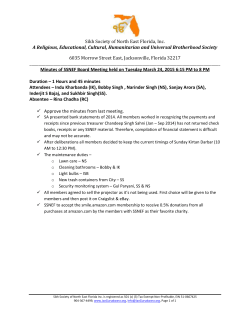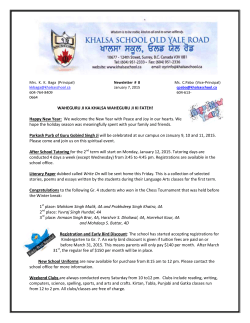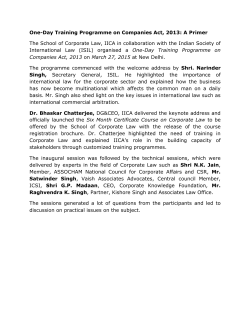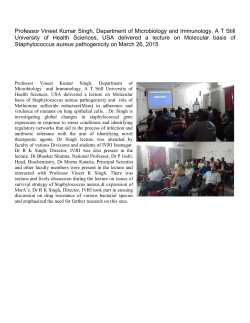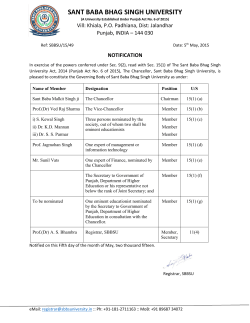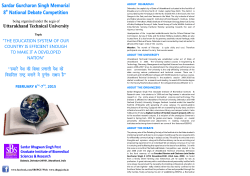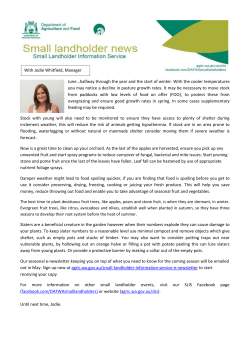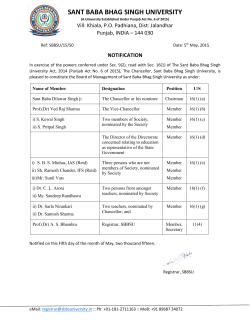
ABSTRACTS: HortFlora Res. Spectrum, Vol. 3 (2), 2015
International Impact Index Coper nicus Value (ICV) : 4.79 : Global Impact Factor (GIF) : 0.287 An International Peer Reviewed-Quar terly Volume 3(2) : June 2014 Index Copernicus International, Poland Indian Science Abstracts CAB Abstracts CABI Full text CiteFactor www.hortflorajournal.com InfoBase Index Google Scholar Research Bib ICRISAT InfoSAT getCited Date of Publication : 30-6-2014 HORTFLORA RESEARCH SPECTRUM Volume 3, Issue 2 : June 2014 ISSN : 2250-2823 www.hortflorajournal.com CONTENTS 1. Tools for Genetic Purity Testing of Horticultural Crops-A Review 2. Physiological Behaviour and Yield Evaluation of Colocasia under Agri-Horti-Silviculture System Combining Ability and Gene Action in Indigenous Bitter Gourd (Momordica charantia L.) Genetic Variability and Divergence Analysis in Okra [Abelmoschus esculentus (L.) Moench] Improving Fruit Quality in Lemon Through INM Effect of Various Chemicals with Packaging and Storage on Tuberose (Polianthes tuberosa L.) Shelf Life Effect of Black Polythene Mulch along with Irrigation on Pre-Harvest Fruit Drop in Plum (Prunus salicina L.) cv. Satluj Purple Effect of Methods of IBA Application on Rooting Performance of Crape Jasmine (Chandani) Softwood Cuttings Effect of Different Post Harvest Treatments, Packaging and Storage Condition on French Bean (Phaseolaus vulgaris L.) Effect of Storage Period and GA 3 Soaking of Bulbs on Growth and Flowering of Tuberose (Polianthes tuberosa L.) cv. Double Impact of Front Line Demonstration on Cabbage (Brassica oleracea var. capitata L.) Yield Improvement in South Tripura Effect of Mulching on Physiological Growth Determinants of Productivity in French Bean (Phaseolus vulgaris L.) Water Requirement and Irrigation Scheduling Through Drip Systems in Cabbage (Brassica oleracea var. capitata) Screening of Pomegranate Germplasm Against Bacterial Blight Evaluation of Different Fungicides and Biopesticides against Stem Rot of Rajmash (Phaseolus vulgaris L.) Farm Labour Requirements of Fruit Growers in Hoshiarpur District of Punjab Genetic Variability, Heritability, Genetic Advance and Correlation Coefficient Analysis in Fenugreek (Trigonella foenum-graecum L.) Influence of Chemical Floral Preservatives on Vase Life of Cut Flowers of Gerbera cv. Ambra Drip Irrigation Scheduling in Tomato (Lycopersicon esculantum Mill.) Biological Control of Stem Rot of Rajmash (Phaseolus vulgaris L.) 3. 4. 5. 6. 7. 8. 9. 10. 11. 12. 13. 14. 15. 16. 17. 18. 19. 20. 21. Role of Calcium Compounds and Ethylene Absorbants in Post Harvest Losses 22. Rejuvenation Effect on Yield and Fruit Quality Contributing Traits of Orange (Citrus reticulata) 23. Response of French Bean (Phaseolus vulgaris L.) cv. Akra Suvidha to Different Nutrition Doses 24. Effect of Different Spacing on Growth, Yield and Economics of Cabbage under North Gujarat Condition 25. Biological Indexing of Citrus Greening Abhishek Katagi, Ravishankar M. Patil and 108-113 Prashant Paramagoudar A.K. Sangwan 114-121 R.S. Verma and M.K. Singh 122-126 Vandana Umrao, S.K. Sharma, Rajeev Kumar, 127-132 Vijai Kumar and Alka Sharma Savreet Khehra 133-137 Jayoti Majumder, Krishan Pal Singh, Sellam 138-141 Perinban, Babita Singh and Puja Rai Monika Gupta 142-145 J.M.S. Rawat, K.K. Singh, V. Rawat and 146-149 Bhupendra Singh B.V.G. Prasad, S. Chakravorty and P. Deb 150-153 Nilima Bhosale, A.V. Barad and Nilesh Bhosale 154-157 Shamsher Singh and M.K. Singh 158-161 B.V.G. Prasad, S. Chakravorty, B.K. Saren and D. 162-165 Panda A. Abdul Haris, Sunil Kumar and A.K. Singh 166-168 Ashish and Anita Arora 169-171 Ramesh Singh, Dileep Kumar Singh and Gaurav 172-174 Singh V. K. Rampal and L.S. Sehgal 175-177 Manoj Kumar Singh 178-180 R. Amith, Ravishankar M. Patil, Prashant 181-183 Paramagoudar and V. Chikkasubbanna A. Abdul Haris and Sunil Kumar 184-186 Ramesh Singh, Dileep Kr. Singh and Gaurav 187-189 Singh Ravishankar M. Patil, Prashant Paramagoudar, 190-192 Abhishek Katagi and K.S. Thippanna M.K. Singh, Vivek Pandey and Shamsher Singh 193-194 Vijeeth C. Hegade, Ravishankar M. Patil and 195-196 Abhishek Katagi Shiv Prakash, C.M. Thakor, B.R. Morwal and 197-198 M.L. Jat Sarbjeet Kaur and Anita Arora 199 (ABSTRACTS) HortFlora Research Spectrum, 3(2):(June 2014) www.hortflorajournal.com ISSN : 2250-2823 1. Tools for Genetic Purity Testing of Horticultural Crops—A Review Abhishek Katagi*, Ravishankar M. Patil and Prashant Paramagoudar K. R. C. College of Horticulture Arabhavi 591218, TQ Gokak, Karnataka, India * E-mail: abhishekkat121@gmail.com ABSTRACT : The primary objective of plant breeding is to develop superior varieties. Varietal purity is one of the main quality requirements of the seed offered for sale as well as for commercial multiplication. Hence seed identity and varietal genetic purity testing is essential component of modern and effective agricultural production system. Several laboratory and field methods are used to determine the cultivar trueness and genetic purity of the seed offering genuine quality seed to the farmers for commercial cultivation. Farmers cannot distinguish the real hybrid seeds from false ones neither the poor quality ones . Hence judicious, sensible application of chemical and molecular tools for rapid genetic purity testing is of much concern for quality seeds to meet our country’s food security. Published in : HortFlora Research Spectrum, 3 (2) : 108-113 (June 2014) 2. Physiological Behaviour and Yield Evaluation of Colocasia Under Agri-Horti-Silviculture System A.K. Sangwan Department of Fruit science, Punjab Agricultural University, Ludhiana 141 004 *E-mail : sangwan2111@gmail.com ABSTRACT: An agri-horti-silviculture model involving fruit trees, poplar (Populus deltoides Bartr. Ex Marsh.) as timber tree and colocasia were evaluated for yield and eco-physiological behaviours. Net photosynthesis, stomatal conductance and transpiration in colocasia were higher in pear × Kinnow combination than in highly shaded area of poplar ones. Colocasia showed better performance under partial shade in yield and yield contributing parameters, and decreased as canopy advanced in age. These parameters showed inverse relationship with canopy age and vice versa with more yield reduction under sixth year old canopy followed by preceding years and control. The transpiration (E) rate of colocasia was lowest under shade conditions irrespective of the crop used in the experiment leading to more water use efficiency in the shade conditions than in open. It is suggested that to minimize resource competition and improve physiological processes of crops, canopy management is essential to ensure better yield under pear-based agri-horti-silvicultural system. Published in : HortFlora Research Spectrum, 3 (2) : 114-121 (June 2014) 3. Combining Ability and Gene Action in Indigenous Bitter Gourd (Momordica charantia L.) R.S. Verma 1 and M. K. Singh 2* Department of Vegetable Science, N. D. U. A. & T., Kumarganj, Faizabad-224229, U.P. India 2 Krishi Vigyan Kendra, East Kameng, Pampoli-790 102, Arunachal Pradesh 1 *E-mail: mr.mksingh2008@rediffmail.com ABSTRACT : The investigation was carried out to get information regarding magnitude of combining ability and nature of gene action for fruit yield and several other yield attributing traits. The trial was designed by following line × tester mating design involving 12 lines and 3 testers and their 36 hybrids tested in two environments viz., summer and rainy season 2010 at Research Farm of Department of Vegetable Science, N.D. University of Agriculture & Technology, Kumarganj, Faizabad, UP. Estimate of gca effects among the lines NDBT-13, NDBT-15 and NDBT-19 during both seasons and NDBT-10 during summer season and among the testers Kalyanpur Sona during summer season and Pusa Do Mausami during rainy season were identified as superior donar for fruit yield per plant and its yield contributing traits like number of fruits per plant and average fruit weight. Eight crosses in the both seasons for fruit yield per plant displayed desirable significant sca effects. Among these eight crosses the best cross combinations based on desirable sca effects for fruit yield per plant were NDBT-19 × Pusa Do Mousami in summer season while NDBT-8 × Pusa Do Mousami, NDBT-15 × NDBT-12 and NDBT-10 × Pusa Do Mousami in rainy season. These crosses are associated with number of fruits per plant, average fruit weight, fruit diameter and other component traits in both seasons. Published in : HortFlora Research Spectrum, 3 (2) : 122-126 (June 2014) 4. Genetic Variability and Divergence Analysis in okra [Abelmoschus esculentus(L.) Moench] Vandana Umrao, S.K. Sharma, Rajeev Kumar, Vijai Kumar1* and Alka Sharma Department of Agricultural Botany, Ch. Shivnath Singh Shandilya (P.G.) College, Machhra, Meerut (U.P.) 1 Deptt. of Horticulture, CSSS (PG) College, Machhra, Meerut * E-mail : umraovk@gmail.com ABSTRACT : An investigation was undertaken to assess genetic diversity of 50 genotypes based on 11 traits using Mahalanobis D2 statistics. Significant variation was noticed for all the traits. High heritability estimates were observed for all the traits except thickness of the fruit. In general phenotypic coefficients of variability were greater than their corresponding genotypic coefficients of variability denoting environmental factors influencing their expressions to some degree or other. High estimates of heritability coupled with high genetic advance and moderate to high GCV were observed for plant height up to 1st fruiting node (cm), no. of first fruiting nodes / plant, no. of branches/ plant and number of fruits per plant. Mahanalobis D2 statistics cluster analysis distributed the 50 genotypes into eight broad clusters. The inter-cluster distance was maximum between cluster II and VII (6.956) followed by cluster I and VII (6.69), cluster IV and cluster VII (6.64) and cluster V and cluster VII (6.588), whereas minimum inter cluster distance was between I and IV (2.239). The characters viz. plant height (cm), plant height up to first fruiting node, no. of branches/ plant and weight per fruit (g) contributed maximum towards genetic divergence and, therefore, selection of divergent parents based on these characters is recommended for getting good hybrids or segregates in okra. The cluster VII genotypes were Parbhani Kranti, ParbhaniTripti and Bio Aparajita were diverse from other clusters and also having highest mean values for plant height (cm), plant height up to first fruiting node and weight per fruit (g). The cluster II genotypes viz.; BO-22 , BH-9, IC-8899, IC-12930, IC-10256 and White Snow had highest mean values for no. of branches/ plant. Published in : HortFlora Research Spectrum, 3 (2) : 127-132 (June 2014) 5. Improving Fruit Quality in Lemon Through INM Savreet Khehra* Punjab Agricultural University, FASS, Amritsar - 143 001, Punjab, India. *E-mail: savreetz@gmail.com ABSTRACT : With a view to harvest superior quality lemon fruits, the experiment was carried out to study the impact of integrated use of inorganic fertilizer (N), organic manure (FYM) and biofertilizer (Azotobacter) on lemon cv. ‘Baramasi’ during 2009. The plant material was selected from Punjab Government Progeny Orchard & Nursery, Attari, Amritsar. There were nine nutrient management practices set in a Randomized Block Design replicated thrice. The present experiment showed that the substantial improvement in fruit quality could be achieved with the consortium of three classes of nutrient sources. FYM (75 Kg/tree), inorganic nitrogen (350g/tree) along with biofertilization (Azotobacter 18g/tree) proved to be the most judicious treatment in minimizing fruit cracking and maximizing fruit quality. Published in : HortFlora Research Spectrum, 3 (2) : 133-137 (June 2014) 6. Effect of Various Chemicals with Packaging and Storage on Tuberose (Polianthes tuberosa L.) Shelf Life Jayoti Majumder * , Krishan Pal Singh, Sellam Perinban, Babita Singh and Puja Rai Directorate of Floricultural Research, IARI, Pusa Campus, New Delhi-110012 * E-mail: jayotisarkar1@gmail.com ABSTRACT: Tuberose occupies a very selective and special position among the ornamental bulbous plants for its beauty, elegance and sweet pleasant fragrance. It is also gaining priority in the loose flower trade. For prolonging the shelf life, tuberose florets (in bud) were harvested from cv. Prajwal, Arka Niranthara and Mexican Single and the shelf life of the harvested buds was studied with Boric Acid (2%, 3% and 4%) and citric acid (150, 300 and 450 ppm). The treated buds were kept in polypropylene (PP) bags with or without vent (0.2%) at 40C. It was found out that in cv. Arka Niranthara had maximum number of open flowers (45.33 %) after five days of treatment in citric acid at 450 ppm with the vented polypropylene bags. The fresh weight loss of the same variety was minimum (14.628 %) in the vented PP bags with 2% boric acid. In cultivar Mexican Single, 150 ppm citric acid and 2% boric acid were at par for shelf life of flowers opening (11.56 and 11.5 days, respectively) in non vented PP bags. The cultivar Prajwal also produced maximum percentage (30.67 %) of bud open after 5 days in 450 ppm citric acid i.e. with vented polypropylene bags. The maximum CO2 rate (129.04 ml CO2 /kg/l) with zero bud rotting was also observed in cv. Prajwal in the treatment of 450 ppm citric acid with vented polypropylene bag. Published in : HortFlora Research Spectrum, 3 (2) : 138-141 (June 2014) 7. Effect of Black Polythene Mulch along with Irrigation on Pre-harvest Fruit Drop in Plum (Prunus salicina L) cv. Satluj Purple Monika Gupta* PAU-Farm Advisory Service Scheme, FaridKot- 151203, Punjab, India. *E-mail: monika-fzr@pau.edu ABSTRACT: The present investigation on “Effect of black polythene mulch along with irrigation on pre-harvest fruit drop in plum (Prunus salicina L.) cv. Satluj Purple” was carried out during 2004 and 2005 at Punjab Agricultural University, Ludhiana. The trees were irrigated at an interval of 3, 5 and 7 days starting from first week of April to the first week of May. Mulching with black polythene and transparent polythene was also done along with irrigation. Black polythene along with irrigation at 5 days interval was the most effective treatment to reduce the pre-harvest fruit drop. The fruit retention (20.74 and 19.84%), yield (14.33 and 13.55 kg/tree), fruit weight (38.52 and 39.15g), TSS (13.55 and 13.67%), TSS/acid ratio (13.29 and 13.27), nitrogen content (2.37 and 2.40%) and carbohydrate content in leaves (9.62 and 10.38%) were also the highest in this treatment. The next best treatment was black polythene mulching and irrigation at 3 days interval. Black polythene delayed fruit maturity by 1-2 days whereas transparent polythene advanced it. Published in : HortFlora Research Spectrum, 3 (2) : 142-145 (June 2014) 8. Effect of Methods of IBA Application on Rooting Performance of Crape Jasmine (Chandani) Softwood Cutings J. M. S. Rawat 1 *, K. K. Singh 1 , V. Rawat 2 and Bhupendra Singh 3 1 Department of Horticulture, 2 Department of Rural Technology, 3 Department of Forestry, HNB Garhwal Central University, Chauras Campus, Srinagar (Garhwal) 246174, Uttarakhand, India *E-mail: jms_rawat99@yahoo.co.in ABSTRACT : The softwood cuttings of Tabernaemontana coronaria were collected from healthy plants under pruning. The cuttings were collected in the month of June. 10-15 cm long cuttings were prepared and treated with different concentration of IBA by quick dip and powder preparation method. The cuttings were planted in root trainers of 100 cc capacity filled with vermi-compost and kept under mist chamber for rooting. The study pointed out that among quick dip and powder preparation of IBA, the powder preparations resulted in better and faster induction of rooting characters and root numbers than quick dip method and control ones in mist chamber. Published in : HortFlora Research Spectrum, 3 (2) : 146-149 (June 2014) 9. Effect of Different Post Harvest Traeatments, Packaging and Storage Condition on French Bean (Phaseolaus vulgaris L.) B.V.G. Prasad*, S. Chakravorty and P. Deb Department of Crop Improvement, Horticulture and Agriculture Botany (CIHAB), Institute of Agriculture, Visva-Bharati, Sriniketan-731236, West Bengal, India. *E-mail: prasadbvg@sify.com ABSTRACT : The present investigation was undertaken to study the effect of different post harvest treatments, packaging and storage condition on French bean. The experiment was conducted under the laboratory of Horticulture Department, Institute of Agriculture, Visva-Bharati University, Sriniketan, West Bengal (India) during the period of January to March 2013. The results from the investigation revealed minimum physiological loss in weight at 14th day (17.41 g/100g), the highest dry matter content (7.68%), total sugar content (3.53 g/100g) and crude protein content (1.33 g/100g) in S3P2 T1 (i.e., Refrigerated storage, perforated polythene packing and CaCl2 treatment) at the final stage of consumption. Published in : HortFlora Research Spectrum, 3 (2) : 150-153 (June 2014) 10. Effect of Storage Period and GA 3 Soaking of Bulbs on Growth and Flowering of Tuberose (Polianthes tuberosa L.) cv. Double Nilima Bhosale 1 *, A.V. Barad, and Nilesh Bhosale 2 College of Agriculture, Junagadh Agricultural University, Junagadh(Gujarat) 2 Department of Agronomy, Anand Agricultural University, Anand (Gujarat) *E-mail : avbarad55@gmail.com;avbarad@jau.in 1 ABSTRACT : The experiment on effect of storage period and GA3 soaking of tuberose bulbs on growth, flowering, flower yield and quality was conducted at Junagadh Agriculture University, Junagadh during 2010-11. The experiment was laid out in factorial randomized block design (FRBD) with three replications and four treatment combinations of storage comprising : S0 - Fresh uplifted, S1 - One month storage (uplifted during 2nd week of January, 2010), S2 - Two months storage (uplifted during 2nd week of December, 2009), and S3 Three months storage (uplifted during 2nd week of November, 2009). These tuberose bulbs were planted in 3rd week of February, 2010 with four GA3 soaking treatments for 12 hours viz. G0 - Control (soaking in distilled water), G1 - 100 mg/l, G2 - 200 mg/l and G3 - 300 mg/l. The bulbs soaked with different concentration of GA3 were kept in shade for half an hour before planting. The results revealed that one month storage period after uplift of bulbs and GA3 200 ppm soaking before planting treatments significantly improved growth parameters (days to sprouting, sprouting percentage and plant height), and floral characters (days to spike emergence, days to first spike harvested and length of spike, number of florets per spike and diameter of floret) over a control treatment. Published in : HortFlora Research Spectrum, 3 (2) : 154-157 (June 2014) 11. Impact of Front Line Demonstration on Cabbage (Brassica oleracea var. capitata L.) Yield Improvement in South Tripura Shamsher Singh 1* and M.K.Singh 2* KVK Hailakandi, (ICAR RC for NEH Region), Assam 2 KVK Pampoli, East Kameng Arunachal Pradesh *E-mail: shamshersinghkvk@gmail.com, mr.mksingh2008@rediffmail.com 1 ABSTRACT : One of the major constraints of traditional cabbage cultivation is low productivity due to non-adoption of recommended package of practices and improved varieties by the Tripura cabbage growers. To replace this anomaly, KVK South Tripura under ICAR Research Complex for NEH Region was conducted 15 frontline demonstrations (FLDs) on recommended production technology of cabbage var. BC-76 in five different villages of the district during Rabi season for two years (2007-08 and 2008-09). Cultivation practices comprised under FLD viz., use of improved variety, recommended planting spacing, balanced fertilizers application and control of pest and diseases. The present study was carried out to know that the yield gaps between improved package of practices and existing farmers practice of cabbage. An average yield of cabbage in FLD ranged from 323.75-338.50 q/ha whereas in existing practice 250.00 q/ha in 2007-08 and 2008-09. Percent increase yield with improved technology over existing practice was recorded in range of 29.50 to 35.40. The extension gap ranging between 73.75-88.50 q/ha during the study period. The trend of technology gap reflected the farmer’s cooperation, in carrying out such demonstrations with encouraging results in subsequent years. Average per hectare net profit was found Rs. 72,000.00 under demonstration while Rs. 42,600.00 under control. The benefit cost ratio was noticed 2.79 and 3.02 with demonstrations whereas 2.37 and 2.48 with farmers practices during 2007-08 and 2008-09, respectively. By conducting frontline demonstration of proven technologies, yield potential from cabbage cultivation can be enhanced to a great extent with increase in the income of the farmers. Published in : HortFlora Research Spectrum, 3 (2) : 158-161 (June 2014) 12. Effect of Mulching on Physiological Growth Determinants of Productivity in French Bean (Phaseolus vulgaris L.) B.V.G. Prasad 1 , S. Chakravorty 1 , B.K. Saren 2 and D. Panda 2 1 Department of Crop Improvement, Horticulture and Agriculture Botany (CIHAB), 2 Department of ASEPAN, Institute of Agriculture, Visva-Bharati, Sriniketan-731236, West Bengal, India. *E-mail: prasadbvg@sify.com ABSTRACT: The present investigation was undertaken at Horticulture Farm, Institute of Agriculture, Visva-Bharati University, West Bengal (India) during winter (rabi) season from December 2012-March 2013 to study the effect of mulching on physiological growth parameters of French bean. The results of plant growth analysis revealed that highest plant height (60.71cm), leaf area index (6.29), dry matter accumulation (826.23 g m -2 ), crop growth rate (14.49 g m -2 day-1) and relative growth rate (1.26 g-1day-1) were observed under paddy straw mulch @ 10 t ha-1. Published in : HortFlora Research Spectrum, 3 (2) : 162-165 (June 2014) 13. Water Requirement and Irrigation Scheduling Through Drip Systems in Cabbage (Brassica oleracea var. capitata) A. Abdul Haris 1 ∗ , Sunil Kumar 2 ∗ and A.K. Singh 3 1 ICAR Research Complex for Eastern Region, ICAR Parisar, P.O. B.V.College, Patna, Bihar, India. 2 Department of Horticulture, North Eastern Hill University, Tura Campus, Chandmari-794 0002, West Garo Hills District, Meghalaya 3 CSSRI Regional Station, Lucknow *E-mail: abdulharis123@rediffmail.com; sunu159@yahoo.co.in ABSTRACT : An experiment was conducted to study the water requirement and irrigation scheduling in cabbage (Brassica oleracea var. capitata). The treatment consisted of three irrigation levels viz. 100%, 80% and 60% on ET (Evapo-Transpiration) basis and three irrigation scheduling viz. daily, once in two days and once in three days in split plot design. It is revealed that significantly higher yield was noticed at 60% ET treatment (569.80q/ha during first year of trial) whereas, 80% ET treatment (703.82 and 488.40q/ha) during second and third year of trial as compared to 100% ET. At 60% ET, irrigation scheduling at once in two days was found significantly superior in the first year while 80% ET with irrigation scheduling once in two days during second and third year of trials with respect to daily and once in three days. Maximum water use efficiency was obtained under irrigation at 60% ET with once in two days (115.81q/ha − cm) irrigation treatment in the three consecutive years of experimentation. Irrigation at 80% ET with once in two days interval may be recommended for better yield and marketability in cabbage. Published in : HortFlora Research Spectrum, 3 (2) : 166-168 (June 2014) 14. Screening of Pomegranate Germplasm Against Bacterial Blight Ashish and Anita Arora * Department of Fruit Science, Punjab Agricultural University, Ludhiana-141 004, Punjab * E-mail:anitapau@pau.edu ABSTRACT : Bacterial blight of pomegranate caused by Xanthomonas axonopodis pv. punicae is one of the most devastating disease affecting pomegranate production in Punjab. Therefore, an experiment was conducted for screening of pomegranate germplasm against bacterial blight at PAU, Ludhiana during 2013. Leaves and fruits of different genotypes of pomegranate were inoculated with clip method and pinprick method on its surface, respectively. Per cent disease index was recorded under artificial inoculated conditions and natural conditions. None of the genotypes exhibited resistant against bacterial blight. Some of the genotypes showed moderately susceptible reaction against bacterial blight of pomegranate. Published in : HortFlora Research Spectrum, 3 (2) : 169-171 (June 2014) 15. Evaluation of Different Fungicides and Biopesticides against Stem Rot of Rajmash (Phaseolus vulgaris L.) Ramesh Singh*, Dileep Kumar Singh and Gaurav Singh Department of Plant Pathology,T.D.P.G.College, Jaunpur (U.P.) *E-mail: ramesh.ramesh.singh37@gmail.com ABSTRACT : Stem rot caused by Sclerotinia sclerotiorum is an important disease of Rajmash (Phaseolus vulgaris L.) in Eastern U.P. The efficacy of seven fungicides and two bio-pesticides were tested in-vitro and invivo. Vitavax (0.10 %), Bavistin (0.10%) and Blitox-50 (0.20%) proved to be most effective in inhibiting the growth of the pathogen and controlling the disease in the field and increasing the yield also. Bio-pesticides, Neemark and Funginil are also proved effective, but slightly less effective than systemic fungicides. Neemark and Funginil being a safe eco-friendly and economical bioproduct, can be used in the control of the diseases. Published in : HortFlora Research Spectrum, 3 (2) : 172-174 (June 2014) 16. Farm Labour Requirements of Fruit Growers in Hoshiarpur District of Punjab V.K. Rampal* and L.S. Sehgal Department of Extension Education, Punjab Agricultural University, Punjab-141004 *E mail: rampalvk@ pau. edu ABSTRACT : The present study was conducted in selected villages of Bhunga and Hajipur blocks of Hoshiarpur district of Punjab to know about the farm labour requirements of fruit growers. After finalizing the research instruments into permanent, family and casual labour, the data were collected through personal interview method from a sample of 90 farmers. Simple analytical tools such as percentage and range method were used for analyzing the data collected. Findings revealed that for a majority (73.33 per cent) of Kinnow growers of Bhunga block, requirement of permanent farm labour varied from 0 to 76 man days per acre whereas fairly large litchi growers (75.56 per cent) of Hajipur block, requirement of permanent farm labour varied from 0 to 82 man days per acre. As it is evident that Kinnow and Litchi growers provide an ample amount of opportunity for farm labour reducing the percentage of unemployment, the cultivation of Kinnow and Litchi in the two blocks of Hoshiarpur district should be mooted. Published in : HortFlora Research Spectrum, 3 (2) : 175-177 (June 2014) 17. Genetic Variability, Heretibility, Genetic Advance and Correlation Coefficient Analysis in Fenugreek (Trigonella foenum-graecum L.) Manoj Kumar Singh* Krishi Vigyan Kendra, East Kameng, Pampoli-790102, Arunachal Pradesh *E-mail: mr.mksingh2008@rediffmail.com ABSTRACT : The results reveal that the higher magnitude of coefficient of variation at genotypic level was observed for number of pods per plant, number of branches per plant, number of seeds per pod, plant height, seed yield per plant, and length of pod, whereas, at phenotypic level, number of pods/plant, number of branches per plant, number of seeds per pod, plant height, seed yield per plant, and length of pod revealed high magnitude of coefficient of variation. In this way, high values of genotypic and phenotypic coefficient of variation was also observed in fenugreek for plant height, days to flowering, branches per plant and test weight and low for pod length, when studied with 22 genotypes in field condition and high genotypic coefficient of variation for number of secondary branches, number of pods per plant and seed yield was observed in fenugreek High heritability coupled with high genetic advance in per cent of mean were observed for number of pods per plant, number of branches per plant, number of seeds per pod and plant height. It is also reported that high heritability for pods per plant, pod length and seed yield, while low heritability was observed for seeds per pod and test weight Published in : HortFlora Research Spectrum, 3 (2) : 178-180 (June 2014) 18. Influence of Chemical Floral Preservatives on Vase Life of Cut Flowers of Gerbera cv. Ambra R. Amith 1 , Ravishankar M. Patil 2 *, Prashant Paramagoudar 2 * and V. Chikkasubbanna 2 A.H.O., Department of Horticulture, Karnataka 2 University of Horticultural Sciences, Bagalkot,Karnataka, India *E-mail: ravishankar.horti@gmail.com; payaprashant@gmail.com 1 ABSTRACT : Gerbera cv. Ambra was subjected to twelve different treatment combinations against control to study the vase life, where treatment with 300ppm Sodium benzoate + 6% sucrose + 400 ppm 8-HQS showed significant beneficial effect in extending the vase life of the cultivar to 14 days, as against 9.03 days of vase life in control. The findings provide an alternative for extending the vase life of cut gerbera flowers. Published in : HortFlora Research Spectrum, 3 (2) : 181-183 (June 2014) 19. Drip Irrigation Scheduling in Tomato (Lycopersicon esculantum MILL.) A. Abdul Haris 1 ∗ and Sunil Kumar 2 ∗ ICAR Research Complex for Eastern Region, ICAR Parisar, P.O. B.V.College, Patna, Bihar, India. 2 Department of Horticulture, North Eastern Hill University, Tura Campus, Chandmari-794 0002, West Garo Hills District, Meghalaya *E-mail: abdulharis123@rediffmail.com.sunu159@yahoo.co.in 1 ABSTRACT : A field experiment was conducted during the year 2001-02, 2002-03 and 2003-04 at Sabajpura farm, LWEERP, Patna on drip irrigation scheduling in tomato. The experiment was conducted in split plot design with irrigation water equivalent to 100, 80 and 60% ET (Evapo Transpiration) in main plots and water as per daily, alternate days and once in three days schedule in sub-plots. Observations regarding yield (q/ha) and water use efficiency (q/ha − cm) was undertaken. This parameter showed better response at 80%ET when plant received irrigation once in three days except for water use efficiency. Yield of tomato per hectare was maximum at irrigation 80% ET (838.5, 967.72, 895.52q/ha, respectively in three consecutive years) and was significantly higher than 100 % Evapo-Transpiration treatment except second year of observations. Irrigation once in three days gave maximum yield (824.10, 940.23 and 904.76q/ha respectively in three consecutive years). Water use efficiency was significantly higher under 80 % ET (96.71q/ha − cm) during the first year. In the 60% ET treatment irrigation once in three days gave maximum water use efficiency (73.07 and 74.18q/ha − cm during first and third year) except second year where maximum water use efficiency (99.23q/ha − cm) under daily irrigation schedule was observed. .Published in : HortFlora Research Spectrum, 3 (2) : 184-186 (June 2014) 20. Biological Control of Stem Rot of Rajmash (Phaseolus vulgaris L.) Ramesh Singh*, Dileep Kr. Singh and Gaurav Singh Department of Plant Pathology,T.D.P.G.College, Jaunpur (U.P.) *E-mail: ramesh.ramesh.singh37@gmail.com ABSTRACT : Stem rot caused by Sclerotinia sclerotiorum is an important disease of Rajmash (Phaseolus vulgaris L.) in Eastern U.P. The evaluation of four fungal and two bacterial bio-agents against the pathogen. Maximum inhibition (84.83%) of growth of the pathogen in-vitro was obtained with Coniothyrium minitans followed by T. viride, T. harzianum, Trichoderma virens and Pseudomonas flourescens. Bacillus subtilis proved to be least effective.In-vivo condition minimum disease incidence (12%) was recorded in the plots treated with Coniothyrium minitans followed by Trichoderma viride (16.0%) as regards to the management of the disease followed by Trichoderma harzianum (20.0%) and Trichoderma virens (28.0%). The maximum disease intensity (36%) was noticed with P. flourescens which proved worst among all the bio-agents Published in : HortFlora Research Spectrum, 3 (2) : 187-189 (June 2014) 21. Role of Calcium compounds and Ethylene Absorbants in Post Harvest Losses Ravishankar M. Patil., Prashant Paramagoudar*, Abhishek Katagi* and K.S. Thippanna 1 University of Horticultural Sciences, Bagalkot, Karnataka, India 1 College of Horticulture, Bidar *E-mail: payaprashant@gmail.com; abhishekkat121@gmail.com ABSTRACT : Since post harvest loss of fruits is one of the major problems in less availability of fruits, hence several methods are adopted to avoid that, from among them post harvest application of calcium compounds and ethylene absorbents are found to be the most effective, cheaply available and easily applicable methods for delaying fruit ripening & senescence and are also found to be effective in control of decay loss. Published in : HortFlora Research Spectrum, 3 (2) : 190-192 (June 2014) 22. Rejuvenation Effect on Yield and Fruit Quality Contributing Traits of Orange (Citrus reticulata) 1 M.K. Singh 1 , Vivek Pandey 2 and Shamsher Singh 3 Krishi Vigyan Kendra East kameng, Pampoli-790 102, Arunachal Pradesh 2 Department of Vegetable Science College of Forestry and Hill Agriculture. Ranichauri Campus, Uttarakhand. Krishi Vigyan Kendra, Hailakandi -788 152, (ICAR Research Complex for NEH Region), Assam *E-mail:mr.mksingh2008@rediffmail.com 3 ABSTRACT : Fruits were collected from the trees indexed for healthiness and freedom from disease from the entire three former field as well as former field. The experiments were conducted during 2011-12 at Research Farm of the Krishi Vigyan Kendra, Pampoli, East Kameng, Arunachal Pradesh. Five representative orchards were selected from each formers field for collection of 1500 number of small and large fruits, respectively. Fruit were chosen from 5 randomly selected plants on the basis of fruit size. Small and large sized fruits were collected from all the four formers of East Kameng district of Arunachal Pradesh. The highest fruit weight (161.3 g/fruit), TSS acid ratio (8.0) along with lowest juice (40.9%) was observed in big size fruits. Maximum juice (53.2%), minimum waste index (0.68). Fresh fruit marketing purpose whereas small sized fruits with higher percentage of juice can be recommended for juice preparation Published in : HortFlora Research Spectrum, 3 (2) : 193-194 (June 2014) 23. Response of French Bean (Phaseolus Vulgaris L.) cv. Arka Suvidha to Different Nutrition Doses Vijeeth C. Hegade, Ravishankar M. Patil and Abhishek Katagi* Kittur Rani Channamma College of Horticulture, Arabhavi. Tq-Gokak, (D)-Belgaum *E-mail: abhishekkat121@gmail.com ABSTRACT : French bean (Phaseolus vulgaris L.) is one of the most important vegetable crops which is grown for its tender green pods. The experiment was conducted at Vegetable Research Farm of K.R.C.C.H. Arabhavi. French bean cultivar Arka Suvidha was taken for study. The experiment was laid out in randomized block design with two replications and eight treatments. Observations were taken for five different parameters. Results varied significantly to all the traits. T4 (40:60:50 kg/ha NPK + 25 t/ha FYM + 2 kg/ha B) was found superior among all the treatments for all the traits. The results of this experiment depict that application of NPK at 40:60:50 kg/ha + 25 t/ha FYM + Boron @ 2 kg/ha was beneficial for French bean cultivation in Arabhavi Published in : HortFlora Research Spectrum, 3 (2) : 195-196 (June 2014) 24. Effect of Different Spacing on Growth, Yield and Economics of Cabbage under North Gujarat Condition Shiv Prakash, C. M. Thakor, B.R. Morwal* and M.L. Jat Department of Horticulture, C. P. College of Agriculture, Sardarkrushinagar Dantiwada Agricultural University, Sardarkrushinagar (Gujarat) *E-mail: morwalhorti@gmail.com ABSTRACT : A field experiment was carried out during rabi season 2010-11 to study the “effect of different spacings on growth, yield and economics of cabbage (Brassica oleracea var. capitata). The results revealed that significantly highest number of leaves (11.99), plant spread (56.43 cm) in North-South and (56.77 cm) in East–West, minimum days taken to first harvest after transplanting (92.25 days), maximum head diameter (14.23 cm) and average weight of head (0.80 kg) were recorded with plant spacing of 60 cm x 45 cm. Highest per cent of plant stands (77.02 %) was obtained with plant spacing of 45 cm x 45 cm. Maximum head yield per plot (25.00 kg) and per hectare (27777 kg) and fodder yield ha −1 (24194 kg) with maximum net realization of ` 171862 were obtained under plant spacing 30 cm x 30 cm. Published in : HortFlora Research Spectrum, 3 (2) : 197-198 (June 2014) 25. Biological indexing of citrus greening Sarbjeet Kaur and Anita Arora Department of Fruit Science, Punjab Agricultural University, Ludhiana, Punjab *E-mail: sarbjeetkaur@pau.edu ABSTRACT : Field identification of greening disease is often difficult because the symptoms on affected trees are sometimes confused with that of zinc and other nutritional deficiencies. The citrus greening disease was detected from source Kinnow plants collected from citrus growing area of the state showing yellowing with green veins or green islands and yellow mottling by biological indexing. Published in : HortFlora Research Spectrum, 3 (2) : 199 (June 2014) HORTFLORA RESEARCH SPECTRUM www.hortflorajournal.com ISSN : 2250-2823 Published under the Auspices of : Biosciences and Agriculture Advancement Society (BAAS) ‘‘Shivalay’’ 98-A Somdutt Vihar, Jagrati Vihar, Garh Road, Meerut-250004 E-mail : hortfloraspectrum.india@gmail.com; submit.hortflorajournal2013@gmail.com
© Copyright 2025
